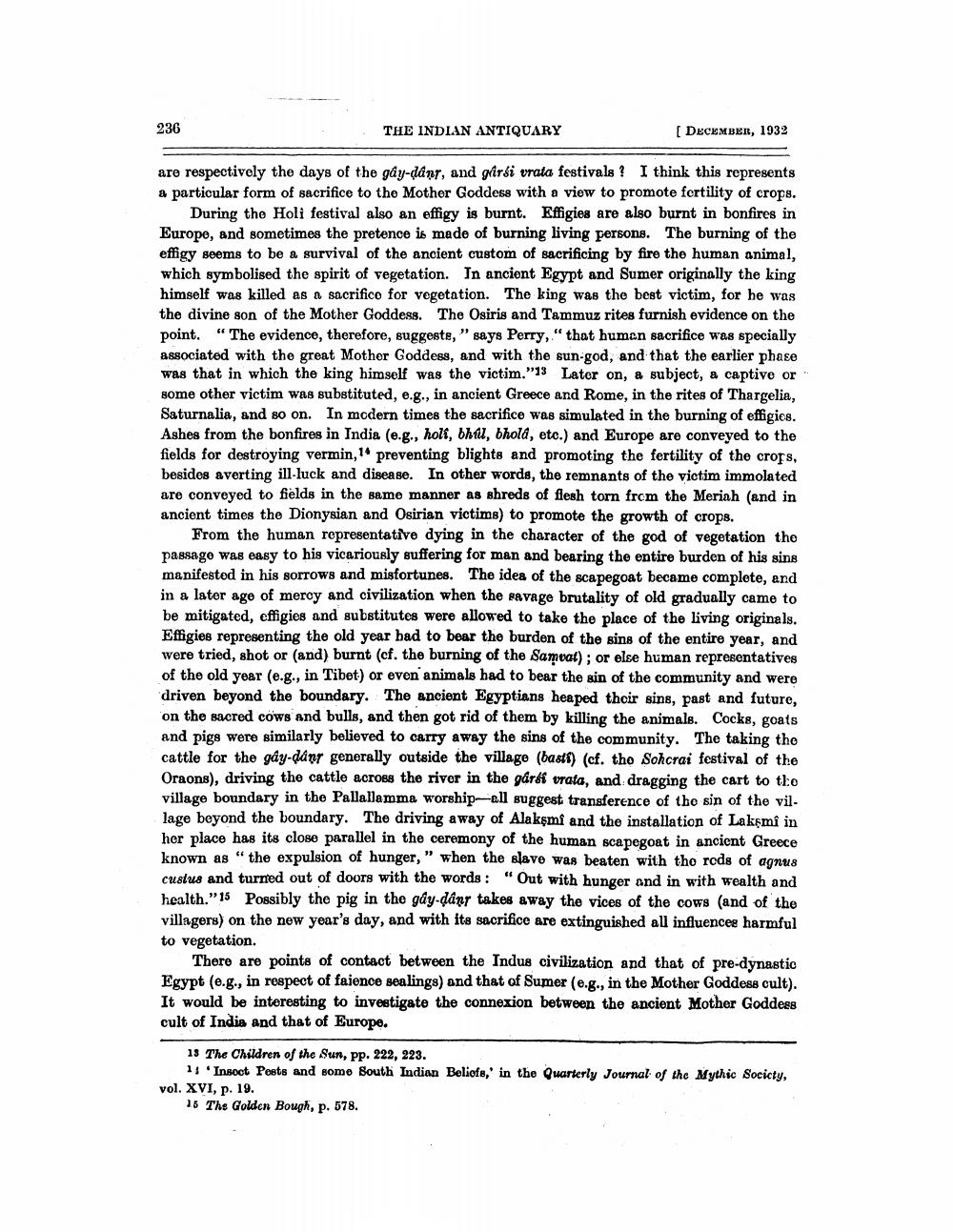________________
236
THE INDIAN ANTIQUARY
[ DECEMBER, 1932
are respectively the days of the gay-dant, and girsi vrata festivals ? I think this represents a particular form of sacrifice to the Mother Goddess with a view to promote fertility of crops.
During the Holi festival also an effigy is burnt. Effigies are also burnt in bonfires in Europe, and sometimes the pretence is made of burning living persons. The burning of the effigy seems to be a survival of the ancient custom of sacrificing by fire the human animal, which symbolised the spirit of vegetation. In ancient Egypt and Sumer originally the king himself was killed as a sacrifice for vegetation. The king was the best victim, for he was the divine son of the Mother Goddess. The Osiris and Tammuz rites furnish evidence on the point. "The evidence, therefore, suggeste," says Perry," that human sacrifice was specially associated with the great Mother Goddess, and with the sun god, and that the earlier phase was that in which the king himself was the victim."13 Later on, a subject, a captive or " some other victim was substituted, e.g., in ancient Greece and Rome, in the rites of Thargelia, Saturnalia, and so on. In modern times the sacrifice was simulated in the burning of effigies. Ashes from the bonfires in India (e.g., holi, bhal, bhold, etc.) and Europe are conveyed to the fields for destroying vermin, 1* preventing blights and promoting the fertility of the cross, besides averting ill-luck and disease. In other words, the remnants of the victim immolated are conveyed to fields in the same manner as shreds of flesh torn from the Meriah (and in ancient times the Dionysian and Osirian victims) to promote the growth of crops.
From the human representative dying in the character of the god of vegetation the passago was easy to his vicariously suffering for men and bearing the entire burden of his sins manifested in his sorrows and misfortunes. The idea of the scapegoat became complete, and in a later age of mercy and civilization when the ravage brutality of old gradually came to be mitigated, effigies and substitutes were allowed to take the place of the living originals. Effigies representing the old year had to bear the burden of the sins of the entire year, and were tried, shot or (and) burnt (cf. the burning of the Samvat); or else human representatives of the old year (e.g., in Tibet) or even animals had to bear the sin of the community and were driven beyond the boundary. The ancient Egyptians heaped their sins, past and future, on the sacred cows and bulls, and then got rid of them by killing the animals. Cocks, goats and pigs were similarly believed to carry away the sins of the community. The taking the cattle for the gdy-dant generally outside the village (basti) (cf. tho Sohcrai festival of the Oraons), driving the cattle across the river in the gardí vrata, and dragging the cart to the village boundary in the Pallallamma worship-all suggest transference of tho sin of the vil. lage beyond the boundary. The driving away of Alakşmi and the installation of Lakşmi in her place has its close parallel in the ceremony of the human scapegoat in ancient Greece known as "the expulsion of hunger," when the slave was beaten with tho rods of agnus custus and turned out of doors with the words : " Out with hunger and in with wealth and health."15 Possibly the pig in the gay-dant takes away the vices of the cows (and of the villagers) on the new year's day, and with its sacrifice are extinguished all influenceg harmful to vegetation.
There are points of contact between the Indus civilization and that of pre-dynastic Egypt (e.g., in respect of faience sealings) and that of Sumer (e.g., in the Mother Goddess cult). It would be interesting to investigate the connexion between the ancient Mother Goddess cult of India and that of Europe.
18 The Children of the Sun, pp. 222, 223.
15 Insoot Posts and some South Indian Beliofe, in the Quarterly Journal of the Mythic Sociсty, vol. XVI, p. 19.
15 The Golden Bough, p. 578.




